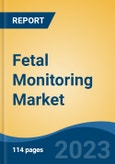Free Webex Call
Global Fetal Monitoring Market is projected to witness impressive growth during the forecast period. The prevalence of premature babies, high birth rates in developing nations, and government initiatives to improve such patients' survival rates are some of the factors that have contributed to the expansion of this market. Additionally, elements, including the rising incidence of nosocomial infections in neonates and rising public awareness of newborn care equipment, are anticipated to support growth.Speak directly to the analyst to clarify any post sales queries you may have.
10% Free customizationThis report comes with 10% free customization, enabling you to add data that meets your specific business needs.
The technological development of fetal monitoring systems, rising birth rates, preterm births, and expanding government and non-government activities to improve maternal and fetal care are all major contributors to the market's growth. Given that it primarily focuses on patient care and comfort, technical improvement in monitoring devices is projected to boost the market's growth. Data sharing with healthcare professionals is made possible by the wireless and at-home monitoring gadgets recently launched to the market. Lifestyle diseases like diabetes and hypertension are the most common causes of preterm delivery.
Growing Number of Premature and Low Weight Births
One of the key factors propelling the expansion of the fetal monitoring market is the rise in preterm and low-weight babies. Prematurity is linked to numerous issues that often cause deaths when birth rates rise. A live birth before 37 weeks of gestation is termed premature, and a delivery weighing less than 2500 g is referred to as a low-weight birth. The "Global Burden of Preterm Birth" study, which was published in the July 2020 issue of the International Journal of Gynecology & Obstetrics, estimates that 11% of all births globally occur preterm. Additionally, one in ten children born in the US in 2020 was born preterm, according to the Centers for Disease Control and Prevention's November 2021 revised entry titled "Preterm Birth." Additionally, there has been an increase in the prevalence of illnesses in neonates. The market need for fetal monitoring equipment has increased. As a result of these considerations, the Global Fetal Monitoring Market is growing.Increasing prevalence of hospital-acquired infections
It is anticipated that the prevalence of hospital-acquired infections among newborns will rise along with consumer knowledge of neonatal equipment. The UN Foundation reports that maternal and infant health is a top issue worldwide since every day, around 800 women are away from preventable causes related to pregnancy or childbirth. Fetal mortality rates are alarmingly high all around the world due to pregnancy-related medical issues. Approximately 20,854 fetal mortalities at 20 weeks or more of gestation were reported in the U.S. in 2020, according to the National Vital Statistics Reports. This highlights the critical need for newborn care equipment.Market Segmentation
The Global Fetal Monitoring Market is segmented based on product, portability, method, application, and end-user. The product segment is classified into ultrasound devices, fetal monitors, uterine contraction monitors, fetal electrodes, fetal doppler devices, telemetry device, accessories and consumables, and others. Based on portability, the market is divided into portable and non-portable systems. Based on application, the market is categorized into antepartum & intrapartum. Based on end-user, the market is categorized into hospitals, obstetrics & gynecology clinic, and home care setting.Recent Developments
- The insertable cardiac monitor (ICM), Jot Dx, was introduced by Abbott in the United States in July 2021. With the use of this technology, patients' cardiac arrhythmias can be remotely detected with greater diagnostic precision.
- The National Institutes of Health (NIH) awarded funds to a Wichita State University research team in September 2022 for their project, "Examining the feasibility of a wearable device for fetal heart rate monitoring through interdisciplinary research."
Market players
Cardinal Health, Medtronic, Koninklijke Philips N.V., Siemens Healthineers, GE Healthcare, FUJIFILM SonoSite, Inc, Natus Medical Incorporated, Huntleigh Healthcare Limited (UK), The Cooper Companies Inc. (US), CONTEC Medical Systems Co., Ltd
Report Scope:
In this report, the Global Fetal Monitoring Market has been segmented into the following categories, in addition to the industry trends, which have also been detailed below:Global Fetal Monitoring Market, By Product:
- Ultrasound Device
- Fetal Monitors
- Uterine Contraction Monitors
- Fetal Electrodes
- Fetal Doppler Device
- Telemetry Device
- Accessories and Consumables
- Others
Global Fetal Monitoring Market, By Portability:
- Invasive
- Non-invasive
Global Fetal Monitoring Market, By Method:
- Invasive
- Non-invasive
Global Fetal Monitoring Market, By Application
- Antepartum
- Intrapartum
Global Fetal Monitoring Market, By Method
- Hospitals & Clinics
- Ambulatory Care Centers
- Homecare
Global Fetal Monitoring Market, By Region:
- North America
- United States
- Canada
- Mexico
- Europe
- France
- Germany
- United Kingdom
- Italy
- Spain
- Asia-Pacific
- China
- India
- Japan
- South Korea
- Australia
- South America
- Brazil
- Argentina
- Colombia
- Middle East & Africa
- UAE
- South Arabia
- Saudi Africa
- Turkey
- Egypt
Competitive landscape
Company Profiles: Detailed analysis of the major companies present in the Global Fetal Monitoring Market.Available Customizations:
With the given market data, the publisher offers customizations according to a company’s specific needs.This product will be delivered within 1-3 business days.
Table of Contents
1. Product Overview
2. Research Methodology
3. Executive Summary
5. Global Fetal Monitoring Market Outlook
6. North America Fetal Monitoring Market Outlook
7. Europe Fetal Monitoring Market Outlook
8. Asia-Pacific Fetal Monitoring Market Outlook
9. South America Fetal Monitoring Market Outlook
10. Middle East and Africa Fetal Monitoring Market Outlook
11. Market Dynamics
12. Market Trends & Developments
14. Competitive Landscape
Companies Mentioned
- Medtronic
- Koninklijke Philips N.V.
- Siemens Healthineers
- GE Healthcare
- FUJIFILM SonoSite, Inc
- Natus Medical Incorporated
- Huntleigh Healthcare Limited (UK)
- The Cooper Companies Inc. (US)
- CONTEC Medical Systems Co., Ltd.
- Cardinal Health








